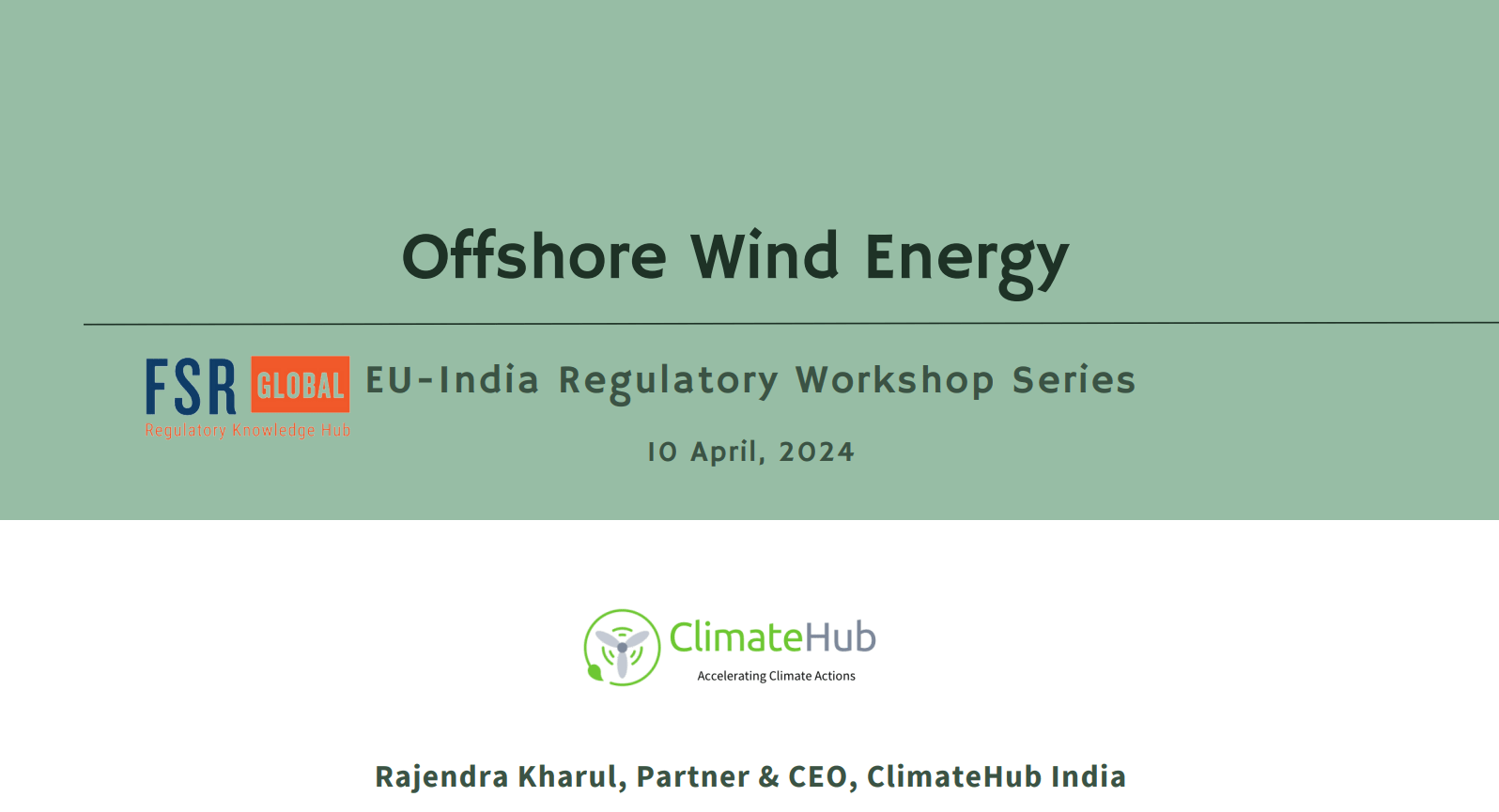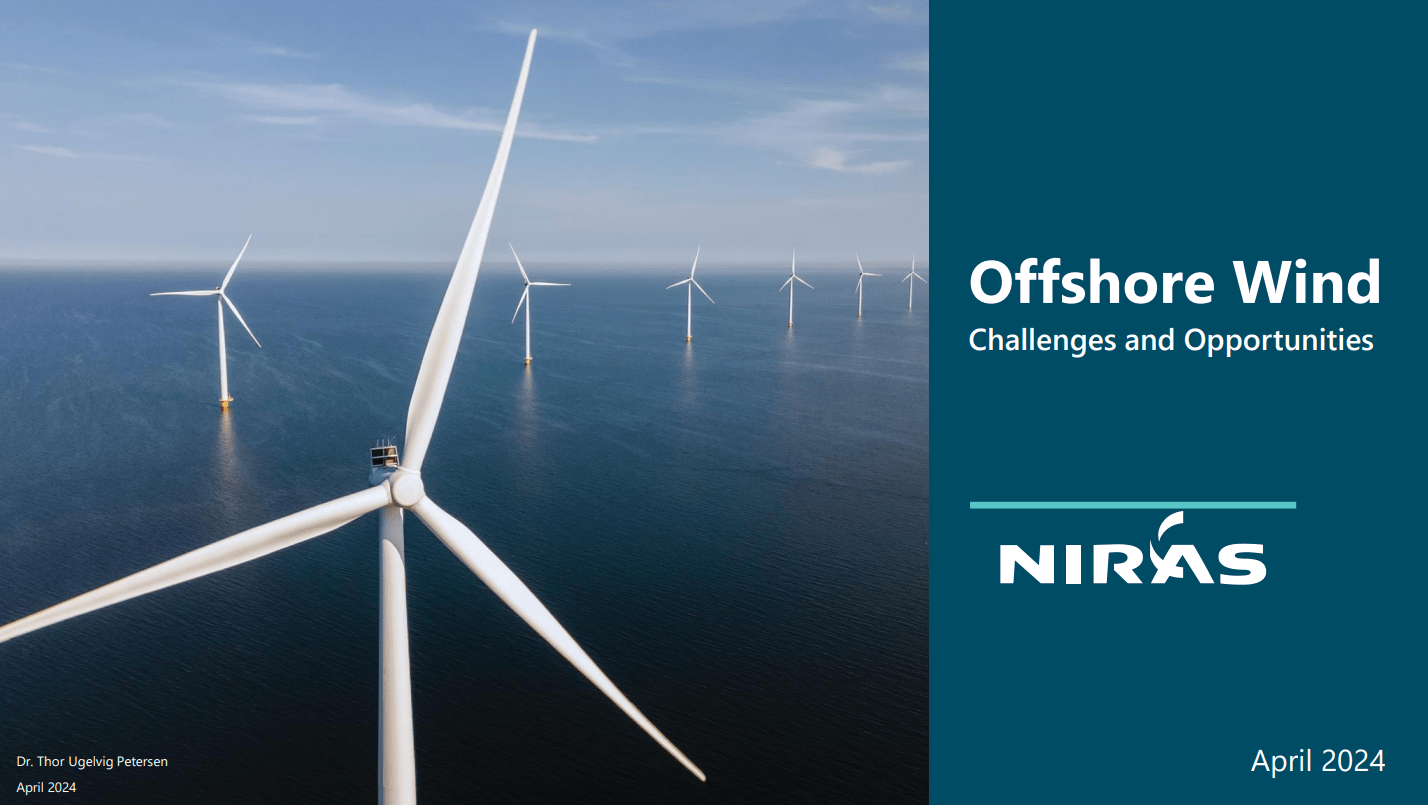Event Highlights
Harnessing the Wind: Challenges, Opportunities, and Lessons Learned

FSR Global
EU-India Regulatory Workshop Series
April 17, 2024
FSR Global hosted a webinar on the topic of #OffshoreWindEnergy as part of the 6th EU-India Regulatory Workshop Series, conducted under the EU-India Clean Energy Climate Partnership.
The speakers were Lalit Bohra, Joint Secretary, Ministry of New and Renewable Energy, Government of India; Alp Gunsever, Head of Secretariat, Centre of Excellence for Offshore Wind and Renewable Energy; Thor Uglevig Petersen, Vice President for Wind Power, NIRAS; Rajendra Kharul, Managing Partner and CEO, ClimateHub India; Johanna Mansson-Delerce, Policy Officer, European Union Delegation to India and Swetha Ravi Kumar, Executive Director, FSR Global The session was moderated by Dr. Parul Bakshi, Research Fellow, FSR Global.
India and the EU are at a crucial juncture in their cooperation, with the drafting of the EU-India Strategic Roadmap 2030 laying the groundwork for strategic collaboration in the next five years. The EU has been a leader in offshore wind energy, with countries like Germany and Denmark pioneering large-scale projects that contribute significantly to their renewable energy portfolios. The EU aims to reach 300 gigawatts (GW) of offshore wind capacity by 2050, a core component of its European Green Deal strategy. India, on the other hand, has set ambitious targets for renewable energy generation capacity and has implemented new market designs, regulations, and network planning strategies. India’s National Offshore Energy Policy marks a major step in harnessing its offshore wind potential, with identified sites along the coastlines of Gujarat and Tamil Nadu being developed in collaboration with Denmark.
The collaboration between India and the EU on offshore wind projects is crucial for both regions, offering economic and environmental benefits. The recently established Trade and Technology Council (TTC) will explore synergies in Indian supply chains for offshore wind, contributing to the resilience of supply chains. The EU-India Clean Energy and Climate Partnership, agreed upon in 2016, focuses on promoting policy and regulatory approaches, business solutions, cooperation, and research in offshore wind and green hydrogen. Together, the EU and India are driving ambitious offshore wind initiatives, unlocking new opportunities for sustainable development and a greener future.
India’s Journey in Offshore Wind Energy
India embarked on its journey in wind energy around 1986. Since then, significant progress has been made, with the latest figures showing the installation of 3,253 megawatts (MW) of wind power in the last financial year, alongside solar installations. This resulted in a total renewable energy addition of over 18 GW in the country. India has set a target to achieve 100 GW of wind capacity out of this, with a total installed capacity of around 46,000 MW and projects totaling about 15,000 MW in the pipeline. India’s trajectory aims to reach this target by 2024-25. The Ministry of Shipping has announced building assistance, offering a 20% capital subsidy for specialized vehicles used in offshore projects. Additionally, the inclusion of offshore wind carbon trading under Article 6 of the Paris Agreement signifies India’s commitment to advancing offshore wind energy.
Offshore Wind’s Crucial Role in India’s Renewable Energy Strategy
Offshore wind plays a crucial role in India’s renewable energy strategy, particularly as the country faces the challenges of grid stability and variability associated with wind and solar power. With over 7,500 kilometres of coastline, India has significant potential for offshore wind development. Initial studies suggest that the capacity factor for offshore wind in India could exceed 50 percent, leading to a reduction in the levelized cost of electricity (LCOE) and ensuring a consistent power supply.
Offshore wind offers several advantages, including high reliability and adequacy, lower storage requirements, reduced balancing needs, and a high potential for employment generation. The scale of offshore wind projects is substantial, with 1GW requiring approximately 250-400 square kilometers. However, to manage costs and build developer confidence, initial projects in India will be closer to shore.
Despite progress, key challenges remain, including high costs and the lack of human experience in the Indian context. As per global trends for 2050, the estimated installed cost per kilowatt is around 2100 USD plus additional costs, and the LCOE is 0.050 USD per kwh, posing a challenge for widespread adoption. Furthermore, there is limited on-ground data and experience, highlighting the need for more studies and data collection to support the industry’s growth.
Policy Support and Industry Development
India has also made strides in policy to support the industry and reduce the burden on developers. The exclusive economic zone (EEZ) along the Indian coast is available for offshore wind development, offering vast potential for growth. The strategy paper for leasing offshore wind sites has outlined three models to facilitate development, with the first model focusing on initial data and survey sharing with prospective developers. This model aims to auction 500 MW each off the coasts of Gujarat and Tamil Nadu.
Infrastructure development is a key focus, with plans for port development in Tuticorin and Kandla to support offshore wind projects. Research and resource assessment activities are being conducted in collaboration with Denmark, with the expectation that once the market matures, India will see a reduction in the cost of wind turbines and the transmission infrastructure required for offshore wind projects. India is setting up Renewable Energy Management Centers (RMCs) to manage the increasing share of renewable energy, ensuring that the integration of offshore wind does not significantly impact the grid.
Moreover, states play a crucial role in offshore wind development, and there is a need for further guidance and coordination at the state level. Clarity on roles, infrastructure development, and capacity building are essential for states to actively participate in offshore wind projects. Coordination between central and state agencies is crucial to streamline project approvals and facilitate the implementation of offshore wind projects.
Challenges and Opportunities in Offshore Wind
Developing offshore wind projects faces several challenges, including port development, which can take between seven to ten years. Assessing available ports early in the development process is crucial. Supply chain constraints, such as vessel availability, pose challenges, with contracts for vessels in offshore wind projects often contracted five years ahead. Balancing grid stability and power delivery from intermittent wind sources is another challenge, requiring sector coupling. The offshore wind industry globally has faced challenges related to increasing costs and inflation, leading to some projects being withdrawn. Competition for resources and competencies in the growing industry remains high, emphasizing the need for knowledge sharing and collaboration in emerging markets like India.
European Market Development and Lessons Learned
Europe has made significant strides in offshore wind energy, with over 2.5 GW of offshore wind capacity installed in 2022. In 2021, Denmark received six bids for offshore wind projects, all at zero cost, indicating a mature market with strong competition. The Danish government’s focus on the pro-market approach and close dialogue with developers has been instrumental in driving market competition. Economic de-risking and financing mechanisms have also supported market development. Denmark’s Maritime Spatial Planning has played a crucial role in identifying suitable areas for offshore wind development. Strategic environmental assessments have been conducted to identify risks and minimize environmental impacts. The country has also implemented a public window to facilitate coordination with other agencies and ensure a transparent process. Denmark has introduced new regulations requiring a minimum of 20% ownership by the state in each offshore wind project. Minimum requirements for environmental impact assessments have also been introduced to ensure sustainable development. These measures aim to improve project quality and reduce environmental impacts.
Future Plans and Qualification Requirements
The future of offshore wind in Europe includes plans for introducing standard support mechanisms and qualification requirements for developers. These requirements may include technical expertise in offshore energy projects and a proven track record in the sector. The aim is to ensure the safety and efficiency of offshore wind projects while maintaining high environmental standards. Many offshore wind farms in Europe are now fully commercial without the need for subsidies, indicating the increasing commercial viability of offshore wind energy. This trend could potentially be mirrored in India as the market matures.
Europe’s offshore wind sector has evolved significantly, with a focus on market competition, environmental sustainability, and stakeholder engagement. The lessons learned from Europe’s experience can provide valuable insights for other regions, including India, looking to develop their offshore wind capabilities.




